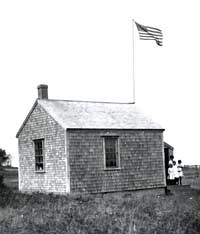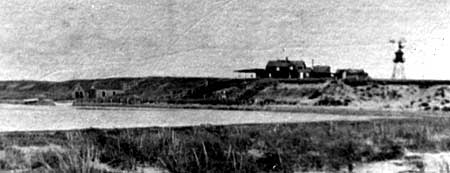Bigelow & His Tuckernuck Retreat
by Frances Kartunen

Tuckernuck School c. 1930s with 3 young girls and a teacherreprinted courtesy Nantucket Historical Assn |
Off Smith’s Point, the extreme western tip of Nantucket, lie two small islands, Tuckernuck and Muskeget. Tuckernuck, the nearer of the two, is plainly visible from anywhere along Nantucket’s North Shore, from Jetties Beach to Madaket. Its Algonquin name is said to mean “loaf of bread.” Tiny, low-lying Muskeget is best seen from the air.
Both islands are off-limits to visitors, fiercely protected by their residents. In the case of Muskeget, the defenders are gray seals that have established a large breeding colony on the island. Tuckernuck’s defenders are its property owners, who occupy the island’s scattering of houses. There is no public land on the island, not even the beaches.
The fact that one needs an invitation to visit Tuckernuck has endowed the place with mystique. Most people who have lived their entire lives on Nantucket have never set foot on its shores, and those who have treasure the experience inordinately. People who have inherited property there constitute a minor aristocracy.
Tiny as Tuckernuck is, it is no stranger to factionalism. Wampanoags from both Nantucket and Martha’s Vineyard traditionally retired to the island for fall duck hunting, and they also buried their dead there. Then, starting in the late 1600s, English settlers let livestock loose on the island. For a while in the early 1700s a little gang of Wampanoag sheep rustlers preyed on the introduced animals, but in a short time the Wampanoags’ traditional hunting land had been lost to the English, who took the island over for farming.

Bigelow House on Tuckernuck. Reprinted courtesy Nantucket Historical Assn
By 1800 Tuckernuck was sustaining forty cows, while between eight hundred and a thousand sheep were cropping the fragile vegetation to the roots. Environmental degradation and rising sea levels have since joined forces to markedly reduce the area of Tuckernuck, and in the process to expose ancient burials that were intended for eternity.
There are no longer any year-round Tuckernuck residents, but until the twentieth century old settler families such as the Tuckernuck Dunhams and Coffins subsisted by farming, hunting, and fishing, while their children received basic education in the Tuckernuck School. Old Tuckernuckers were a close-knit society of cousins.
Enter yet a new group. Seasonal hunting remained excellent on both Tuckernuck and Muskeget, and in the late 1800s groups of recreational hunters from the mainland acquired land for themselves. Gradually their hunting camps and blinds evolved into retreats for Boston Brahmins and their friends. This was a privileged male society, as different as could be from the farm folk they were moving in on. Each side regarded the other as exotic.
At the beginning of the 1880s Henry Jacob Bigelow, son of Jacob Bigelow—botanist, surgeon, and Harvard Medical School professor—had a house built for himself on the western shore of Tuckernuck. A physician like his father, Henry Jacob was a surgeon and a pioneer in the use of surgical anesthetic. It was taken for granted that medicine would be the family profession, passed on from generation to generation. Henry had just one child, a son named William Sturgis Bigelow. William’s mother died when he was still a child, and although he pleased his father by becoming a crack shot who could drop birds out of the sky with the best of them, his nature rebelled against the practice of medicine. Having earned a medical degree, he took off on an extended tour of Europe, not returning to Boston till he was 29. Two years later he escaped again by accompanying Harvard professor Edward S. Morse to Japan. Staying on for eight years, William Sturgis Bigelow studied Japanese culture, collected Japanese art, converted to Buddhism, and was decorated by the Emperor of Japan with the Order of the Rising Sun.

William Bigelow’s library on Tuckernuck, reprinted courtesy Nantucket Historical Assn
By now it was clear that this Bigelow would never practice medicine, nor would he give his father a grandson to carry on the family name and profession. Instead, he became a lecturer on Buddhism and Japanese culture at Harvard and cultivated a circle of men friends. Among them were Brooks Adams; Henry Adams, who married Bigelow’s first cousin; Senator Henry Cabot Lodge and his son, who was known as “Bey” Lodge; John LaFarge; and Theodore Roosevelt. Edith Wharton would have liked to be part of their group, but finding herself excluded, she contented herself with sniping from the sidelines. Of Bigelow she remarked acidly that ‘his erudition far exceeded his mental capacity.”
All the men in Bigelow’s circle dabbled in Buddhism, and much of the dabbling took place during summers at the Bigelow house on Tuckernuck. There Bigelow amassed a library of three thousand volumes, many in French and German, and some reportedly racy. Some were rare old volumes, and some were publications by Bigleows of past generations. Part of the collection dealt with the spiritual and the occult, and also included were French cartoon books poking fun at human nature. Visitors to Bigelow’s Tuckernuck retreat were welcome to spend the day discussing metaphysics in their pajamas, while Bigelow himself favored his Japanese kimono. For breaks from intellectualizing, there was a waterside tennis court and a Japanese bath. Women were absolutely banned, and skinny-dipping was encouraged. From sweltering mid-summer Washington, D.C. Senator Lodge wrote of his impending visit to Tuckernuck, “Surf, Sir! And sun, Sir! And Nakedness! Oh Lord, how I want to get my clothes off!”
Bigelow’s only house rule was that his guests had to dress for dinner. He set a good table with excellent food (often fresh-caught bluefish) and fine wine.
During these summers, Bigelow kept a journal that he called "Notes on the Universe and Kindred Topics as Seen from Tuckernuck.” Then a pair of misfortunes cast a shadow over Bigelow’s off-shore idyll. A friend named Trumbell Stickney died suddenly on the eve of a trip to the island, and in the summer of 1909, Bey Lodge suffered a seizure and died on Tuckernuck. Both were young men in their thirties. As Bigelow brooded over these losses, the encroaching sea took a bite out of the corner of his tennis court. Sensing that his house was now haunted, Bigelow abandoned Tuckernuck.
Upon his death, fifteen years after that of Bey Lodge, Bigelow was cremated. Half of his ashes were interred in the Mount Auburn Cemetery in Cambridge, and the other half were carried to Japan and interred by a Buddhist temple in Kyoto. His superb art collection became a cornerstone of the Asian collection of the Boston Museum of Fine Arts.
The eroding shore continued to creep ever closer to the Bigelow house on Tuckernuck, and at the end of the 1930s it was partly demolished and partly moved to the other side of the island, where it was incorporated into the LaFarge family house. The rarest and best of Bigelow’s books had been taken to the mainland, but the rest remain on Tuckernuck with the LaFarge family.
Bigelow’s Tuckernuck journal is now part of the manuscript collection of the Nantucket Historical Association.
Many thanks to Bancel LaFarge for help with this column.
Frances Karttunen’s book, The Other Islanders: People Who Pulled Nantucket’s Oars, is available at bookstores and from Spinner Publications, New Bedford. Look for Law and Disorder in Old Nantucket in bookstores this summer.
|
|